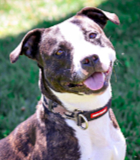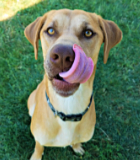Teaching Your Dog to Lie Down
- This topic has 0 replies, 1 voice, and was last updated 14 years, 11 months ago by
Mackenzie’s Admin.
-
AuthorPosts
-
June 17, 2010 at 5:15 pm #540
Mackenzie’s Admin
MemberIf you want a well-mannered dog, teaching him to lie down on command, or cue, is a must. This useful skill can help your dog control his impulses and help you control your dog. There are all kinds of things a dog can’t do if he’s lying down—including jumping up, running off, begging at the table, chasing the cat, knocking over the kids, counter surfing and dashing out the door. A dog in a Down is a good dog!
Training Steps
Step One: Luring Your Dog into Position
To teach your dog to lie down on cue, you need to get him into the right position and then reward him. An easy way to get started is to use a method called luring.Start with your dog in a Sit.
Say the cue, “Down.”
Hold a tasty treat firmly between your fingers so that your dog can smell it and lick it but not eat it. Put the treat right in front of your dog’s nose. Then slowly move it straight down toward the floor, between his front legs. As your dog’s nose follows the treat, just like a magnet, his head will bend all the way down to the floor. When the treat is on the floor between your dog’s paws, start to move it away from him, like you’re drawing a line along the floor. (The entire luring motion forms an L shape.)
To continue to follow the treat, your dog will probably ease himself into the Down position. The instant his elbows touch the floor, say “Yes!” and immediately let him eat the treat from your fingers.If your dog doesn’t automatically stand up after eating the treat, just move a step or two away to encourage him to move out of the Down position. Then repeat the sequence above 15 to 20 times. When your dog readily follows a lure into the Down, you can try the next step. Some dogs will be ready for Step Two after just one or two training sessions. Others will need a few days of practice first. (Aim for at least two short sessions per day. Keep sessions short and sweet—just 5 to 10 minutes each.)
Troubleshooting
If your dog doesn’t follow a treat with his nose when you try to lure him, he might not be interested in that particular treat. Try using something more exciting, like a small piece of chicken, cheese or hot dog.
If your dog’s back end pops up when you try to lure him into a Down, quickly snatch the treat away. Then immediately ask your dog to sit and try again. It may help to let your dog nibble on the treat as you move it toward the floor.
If you’ve tried to lure your dog into a Down but he still seems confused or reluctant, try thistrick:
Sit down on the floor with your legs straight out in front of you. Your dog should be on your right or left side. Keeping your legs together and your feet on the floor, bend at the knee so that your legs make a “tent” shape.
Hold a treat right in front of your dog’s nose. As he licks and sniffs the treat, slowly move it down to the floor and then underneath your legs. Continue to lure your dog until he has to crouch down to keep following the treat.
The instant his belly touches the floor, say “Yes!” and let him eat the treat.
If your dog seems nervous about following the treat under your legs, make a trail of treats for him to eat along the way.Some dogs find it easier to follow a treat into the Down from a standing position.
Hold the treat right in front of your dog’s nose, and then slowly move it straight down to the floor, right between his front paws. His nose will follow the treat.
If you let him lick the treat as you continue to hold it still on the floor, your dog will probably plop into the Down position.The moment he does, say “Yes!” and let him eat the treat.
Many small dogs and dogs with short fur are reluctant to lie down on a cold floor. It may be easier to teach these dogs to lie down on a carpet, couch or dog bed.Step Two: Introducing a Hand Signal
Now you’re going to teach your dog to follow your empty hand into the Down position. You’ll still reward him with treats, though, so keep them nearby or hidden behind your back.Start with your dog in a Sit.
Say “Down.”
Without a treat in your fingers, use the same hand motion you did before.
As soon as your dog’s elbows touch the floor, say “Yes!” and immediately get a treat to give him. (Important note: Even though you’re not using a treat to lure your dog into position, you must still deliver a reward when he lies down. You want your dog to learn that he doesn’t have to see a treat to get one!)
Clap your hands or take a few steps away to encourage your dog to stand up. Then repeat the sequence from the beginning 15 to 20 times. Practice this step for a week or two. When your dog readily lies down as soon as you say the cue and then use your new hand signal, you can proceed to the next step.Troubleshooting
If your dog doesn’t follow your empty hand into a Down, resist the temptation to bring out a treat to lure him. Just be patient, and wait for him to lie down on his own.
If you’ve repeatedly tried to get your dog to lie down using your new hand signal with no luck, try the “fake ‘em out” trick:
Use a treat to lure your dog into the Down position four times in a row, as fast as you can. (Be sure to reward him each time he lies down.)
Then, right after the fourth repetition, use your empty hand to make the Down hand signal. Your dog will probably lie down, thinking that you’re holding a treat.
As soon as his elbows hit the floor, say “Yes!” and open your hand to show him that there’s nothing in it. Then immediately deliver three surprise treats.
Repeat the sequence above a couple more times. Then practice using only the hand signal.Step Three: Shrinking the Hand Signal
You probably don’t want to keep bending all the way down to the floor to guide your dog into the Down with your hand signal. To make things more convenient, you can gradually shrink the signal so that it becomes a smaller movement. To make sure your dog continues to understand what you want him to do, you’ll need to progress slowly.Repeat Step Two, but instead of guiding your dog into the Down by moving your hand all the way to the floor, move it almost all the way down. Stop moving your hand when it’s an inch or two above the floor. Practice the Down exercise for a day or two, using this new, slightly smaller hand signal. Then you can make your movement an inch or two smaller, stopping your hand three or four inches above the floor. Then, after practicing for another couple of days, you can shrink the signal again. As you continue to gradually stop your hand signal farther and farther away from the floor, you’ll bend over less and less. Eventually, you won’t have to bend over at all. You’ll be able to stand up straight, say “Down,” and then just point to the floor.
Step Four: Taking It on the Road
Your next job is to practice your dog’s new skill in many different situations and locations so that he can lie down whenever and wherever you ask him to.Gradually Add Distractions
Set your dog up to succeed by increasing the level of distraction slowly. First, practice in calm places, like all the rooms in your house, in your backyard at a quiet time of day and in front of your house when there’s no one else around. Then try slightly more distracting environments. You can practice in your house when family members are moving around. Try practicing on walks and at friends’ houses, too. When your dog can reliably lie down in these distracting places, add even more distractions. Try practicing while someone bounces a ball or squeaks your dog’s favorite toy nearby. (You can reward your dog by playing a quick game right after he lies down.) Practice when you and your dog are playing at the park together, when guests ring the doorbell and your dog wants to greet them, and when your dog is hanging out with dog friends.
Troubleshooting
If your dog doesn’t lie down on cue when you move to a new location to train, be patient and remind him what you’d like him to do. You can use a treat to lure him into position a few times, just like you did during the first stage of training. After a few reminder repetitions with the lure, go back to using your hand signal. (Don’t forget to deliver a few delicious treats when your dog finally gets it right!)
If you’re trying to train in a new, distracting place and your dog seems totally unable to focus on you, you may have increased the level of distraction too quickly. Try going back to a less distracting location to practice for a while. After a few successful sessions, you can try increasing distraction again, just a little.Step Five: Using Fewer Treats
Most people don’t want to carry treats around all the time. When your dog’s a pro at lying down one cue in many different locations and situations, you can start to gradually reduce the number of treats he gets.Start rewarding only the fastest Downs. If your dog lies down very slowly and reluctantly, he’s still a good boy, so feel free to give him praise and a scratch or two—but only the best Downs earn treats!
You can also start using “life rewards” to show your appreciation for good behavior. Your dog can work for everything he wants. In fact, most dogs love a job! Ask for a Down before you attach your dog’s leash to go on a walk, before you throw his favorite toy, before you give him his dinner, before he’s allowed to greet people, before you let him off leash to play, etc. When your dog discovers that lying down scores him all kinds of good things, he’ll be much more likely to do it when you ask.
Additional Training Tips
Aim for two to five short training sessions per day. Each session should last only 5 to 10 minutes.Train when your dog’s hungry so that he’s extra-motivated to work for his treats. Right before his dinnertime is a great time work on the Down.
Train after your dog has had a good play session or a long walk. If he’s been exercised, it will be easier for him to lie down.
Don’t hesitate to contact a Certified Professional Dog Trainer (CPDT) to help you teach your dog to lie down. Many CPDTs offer group obedience classes or private training sessions. Please see our article on Finding Professional Help to locate a CPDT in your area.
For general dog training tips, please see our articles on Training Your Dog and Clicker Training Your Pet. -
AuthorPosts
- You must be logged in to reply to this topic.











































